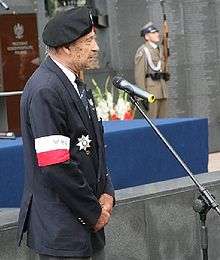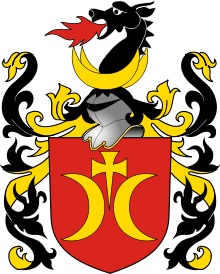Zbigniew Ścibor-Rylski
| Zbigniew Ścibor-Rylski | |
|---|---|
 Ścibor-Rylski, speaking during a ceremony on marking the 63rd anniversary of the Warsaw Uprising (July 30, 2007) | |
| Nickname(s) | Motyl, Stanislaw |
| Born |
March 10, 1917 Brovki-Pershi |
| Allegiance | Poland, Armia Krajowa |
| Service/branch | Aviation, infantry |
| Years of service | 1936–1945 |
| Rank | Brigadier General |
| Unit | 27 Volhynian Infantry Division |
| Battles/wars | World War II (Battle of Kock, Warsaw Uprising) |
| Awards | Virtuti Militari, Order of Polonia Restituta, Cross of Valor, Partisan Cross, Warsaw Cross of the Uprising |
Zbigniew Ścibor-Rylski (Ostoja coat of arms), also known under the pseudonyms Motyl and Stanislaw (born March 10, 1917), is a former Polish aviator, soldier, and participant of the Warsaw Uprising of World War II. A former Polish Air Force officer, he fought alongside the resistance movement since 1940, and rose through the ranks of Armia Krajowa.
Ścibor-Rylski retired with the rank of Brigadier General in the Polish Land Forces, he was rewarded several Polish awards and decorations, including Virtuti Militari. He is Chairman of the Association of Warsaw Insurgents.[1]
Biography
Childhood and youth

Zbigniew Ścibor-Rylski was born at the height of World War I, in Brovki-Pershi (Polish: Browki), a village near Kiev, in present-day Ukraine. He belonged to a Polish aristocratic (szlachta) family from the Clan of Ostoja, being the son of Oscar Ścibor-Rylski and Maria Raciborowska. Located in territory controlled at the time between Russia's republican government, Brovki is the central key estate, which included the Spiczyńce (from his Marszycka grandmother) and Wolica Zarubieniecka (from his Raciborowski grandparents).[1]
In 1918, a year after the outbreak of the October Revolution in Russia, he fled with his family to Bila Tserkva (Biała Cerkiew), in Volhynia, and then to Kiev. After the battle of Kiev by Polish troops under Edward Smigly-Rydz in 1920, the Ścibor-Rylskis left for the newly independent Polish Republic. They settled in Lublin region, initially in Studzianki, then in Zwierzyniec (near Zamosc), where his father Oscar was offered a post within the county Maurycy Klemens Zamoyski in the Zamość Ordinance.[2]
It was in Zwierzyniec that Ścibor-Rylski spend his remaining childhood years, until 1935. He attended the all-male Jan Zamoyski High School in Zamość, and then, after his fourth year, the Sułkowski family Gymnasium near Leszno, graduating in 1936. Shortly after this, he passed the Aviation Cadet School in the technical group in Warsaw, preceded by a glider aircraft course in Ustianowa. Originally training on "Wrony" and "Salamandry" in Ustianowa, he was, from 1939, testing aircraft in a wind tunnel at the Warsaw Polytechnic, working with bombers (PZL.37 Łoś, PZL.23 Karaś) and PZL P.7 fighters for the Polish Air Force Academy. In 1939, he graduated from the School of Aviation Cadets as Cadet Sergeant Engineer, specializing in aircraft engines and equipment. Given the first option for further air service, he selected the 1st Aviation Regiment, based at Warsaw's Okecie Airport. His graduation and promotion to Second Lieutenant were prevented by the outbreak of World War II.[2]
World War II
During the Invasion of Poland by Nazi German troops (September 1939), Zbigniew Ścibor-Rylski served in the 1st Aviation Regiment: on September 6, he left Warsaw in the squadron of Major Władysław Prohazko. Initially on trucks, and then on foot, the group broke through German lines and retreated to the east. They took part in other clashes, rallying with the Independent Operational Group Polesie, under the command of Brigadier General Franciszek Kleeberg. After the capitulation of Kock, he attempted to break through to Romania, but he was captured in the village called Krzywda. After an escape from the prisoner-of-war camp, Ścibor-Rylski returned to Warsaw and joined the underground resistance movement, where he was introduced by his former commander Prohazko. He was sworn into the movement in September 1940, receiving the nom de guerre Stanislaw. From 1940 to June 1943, he worked in pharmaceutical company, Przemyslowo-Handlowe Zaklady Chemiczne Ludwik Spiess i Syn Spólka Akcyjna (the present-day Polfa factories). In parallel, from 1941, he was a partisan fighter behind the Eastern Front, in Kovel.[1]
Beginning January 1944, Zbigniew Ścibor-Rylski was engaged in fighting alongside Armia Krajowa's 27 Volhynian Infantry Division, throughout its advance route. From July of that year, he was in Warsaw, taking part in the Warsaw Uprising in the ranks of battalion Czata 49 Battalion, based at the "Radosław" training camp. He was a company commander in the Sokół 50 Infantry Battalion.[1]
The end of the war found Major Zbigniew Ścibor-Rylski, by then also known under the code name Motyl ("Butterfly"), in Łowicz. Following the German capitulation of April, he reported to Lieutenant Colonel Jan Mazurkiewicz that he had decided to terminate his activity with the resistance movement and return to civilian life in Poznań.[1]
Post-war period
After the war and during the early years of the Polish communist regime, Ścibor-Rylski was head of the Bureau of Automobile Repairs Motozbyt in Poznań and then, from 1956, was employed by a worker cooperative (Zjednoczonych Zespołach Gospodarczych INCO). In August 1984, he joined the Civic Committee of the Commemoration of the 40th anniversary of the Warsaw Uprising.[1]
As member of the Association of the 27 Volhynian Infantry Division and the Kleeberg Association of Independent Operational Group Polesie, he also belonged to the initiative group of the creation of the Warsaw Uprising Museum. Ścibor-Rylski was also in the Honour Committee for the Museum's Construction. He is one of those who signed the protest against the building of the Warsaw monument to the victims of massacres in Volhynia in the form proposed by Marian Konieczny.[1] From December 1, 2004, he is a member of the Virtuti Militari Order's Chapter.[3]
Collaboration with communists
According to documents gathered by the National Remembrance Institute,[4] Ścibor-Rylski was registered as an informant of the communist secret police Służba Bezpieczeństwa.[5][6][7]
Private life
Zbigniew Ścibor-Rylski has three sisters: Kalina, Ewa, Danuta. His is married to Zofia Kochanska (also known as Marie Springer, she was also a soldier of the Armia Krajowa, working in intelligence). They have a son, Maciej.
Ranks
- Lieutenant - September 4, 1939
- First Lieutenant - 1943
- Captain - August 28, 1944
- Major - October 2, 1944
- Pułkownik in reserve - after the war
- Brigadier General in reserve - May 7, 2005
Awards and distinctions
 Virtuti Militari, Silver Cross (twice)
Virtuti Militari, Silver Cross (twice) Polonia Restituta, Grand Cross[8][9]
Polonia Restituta, Grand Cross[8][9] Polonia Restituta, Commander's Cross with Star[10]
Polonia Restituta, Commander's Cross with Star[10]Cross of Valour (Poland), twice
 Partisan Cross
Partisan Cross Warsaw Uprising Cross
Warsaw Uprising Cross Pro Patria Medal[11]
Pro Patria Medal[11]- Augustus Ferdinand Wollf Medal - the highest award of Warsaw Medical Association, presented to Ścibor-Rylski by Association President Jerzy Jurkiewicz
- Honorary Citizen of the City of Warsaw[12]
See also
References
- 1 2 3 4 5 6 7 (Polish) Biography of Zbigniew Ścibor-Rylsk, at the Memorial Association of the 1944 Warsaw Uprising; retrieved June 14, 2010
- 1 2 (Polish) Biography of Zbigniew Ścibor-Rylski, Warsaw, June 20, 2005, at the Warsaw Uprising Museum; retrieved June 14, 2010
- ↑ (Polish) Virtuti Militari, at the Sejm of the Republic of Poland; retrieved June 14, 2010
- ↑ "TRAGICZNE - Zbigniew Ścibor-Rylski współpracownik UB od 1947 roku | Blogmedia24". blogmedia24.pl. Retrieved 2015-10-18.
- ↑ "Ważne pytania w sprawie generała Zbigniewa Ścibora-Rylskiego, po jego sensacyjnej deklaracji, że to on wyciągał informacje z UB". wpolityce.pl. Retrieved 2015-10-18.
- ↑ "Tochman: Kilka, może kilkanaście procent żołnierzy AK i NSZ współpracowało z UB i SB". www.fronda.pl. Retrieved 2015-10-18.
- ↑ "Instytut Pamięci Narodowej | Marek Lachowicz, Wspomnienia cichociemnego". ipn.gov.pl. Retrieved 2015-10-18.
- ↑ Monitor Polski, Issue 27/2010, pos. 251 - point 1
- ↑ (Polish) List of veterans decorated by the President, at the Polish Presidency official site, September 2, 2009; retrieved June 14, 2010
- ↑ Monitor Polski, Issue 31/1999, item 481 - point 1
- ↑ http://www.udskior.gov.pl/Uroczystosc,wreczenia,odznaczen,w,Palacu,na,Wodzie,w,warszawskich,Lazienkach,256.html#content
- ↑ (Polish) "Protokół Uroczystej sesji Rady m. st. Warszawy z okazji Dnia Pamięci Warszawy odbytej w dniu 31 lipca 2008 r. na Zamku Królewskim w Warszawie", in Warsaw's Public Information Bulletin of the Capital City of Warsaw, July 31, 2008